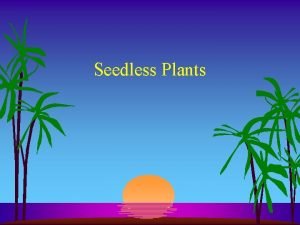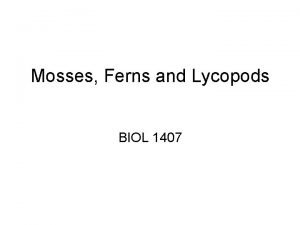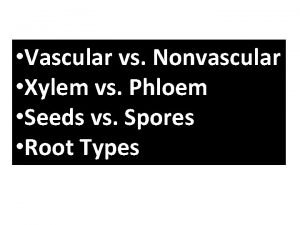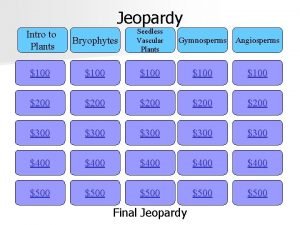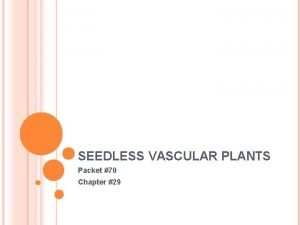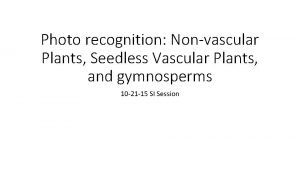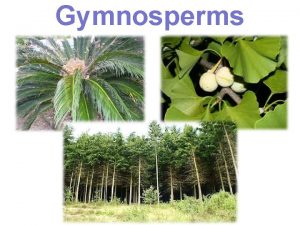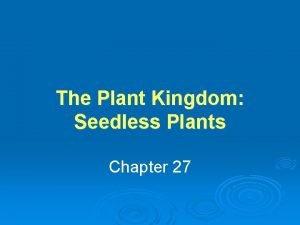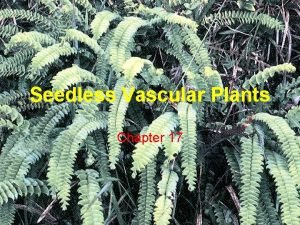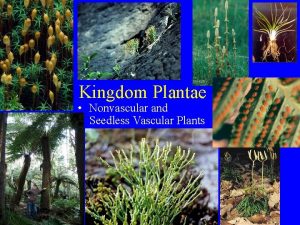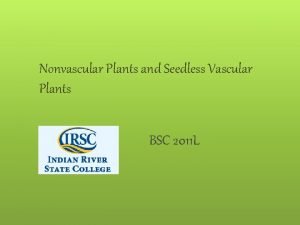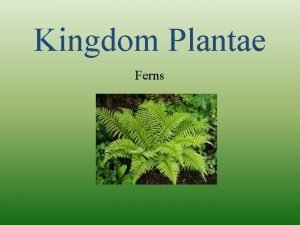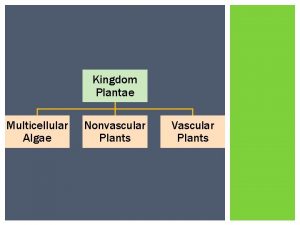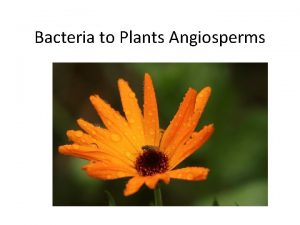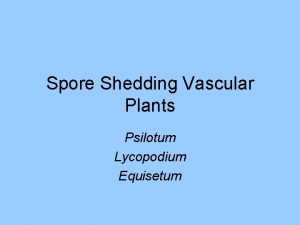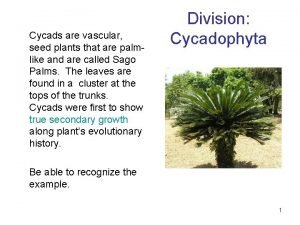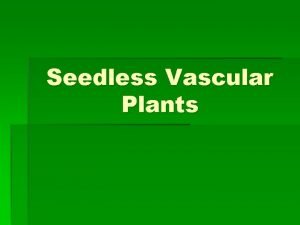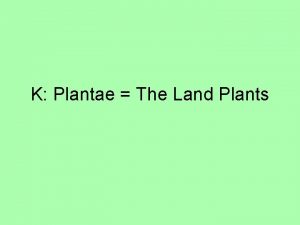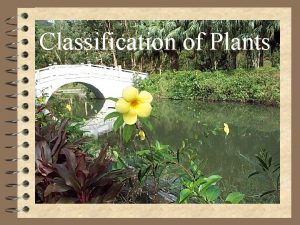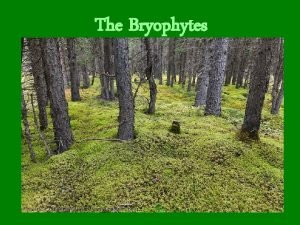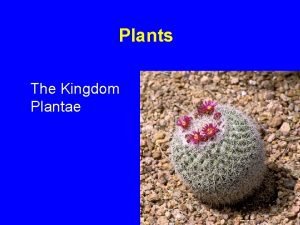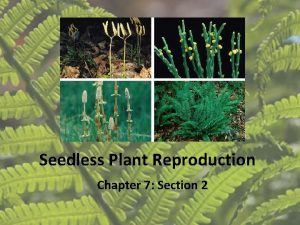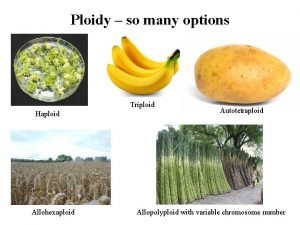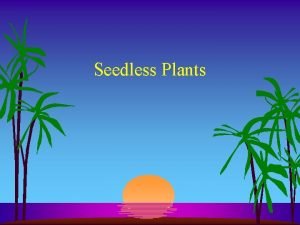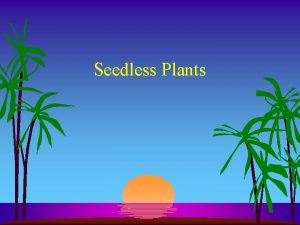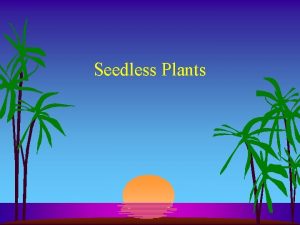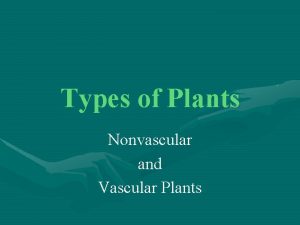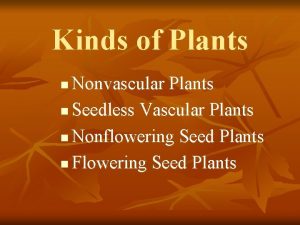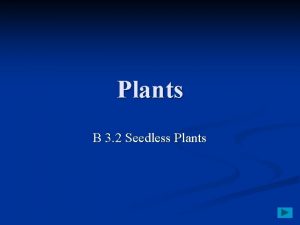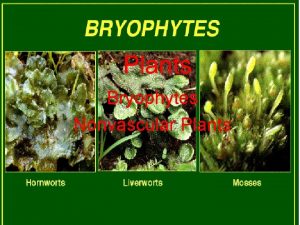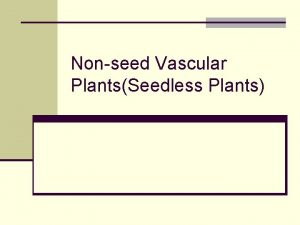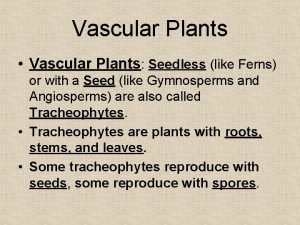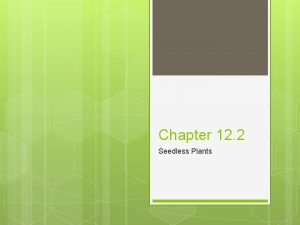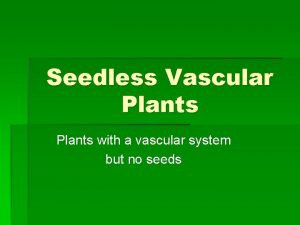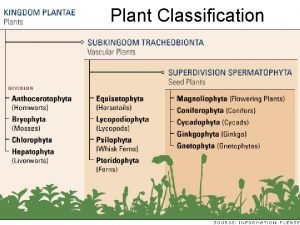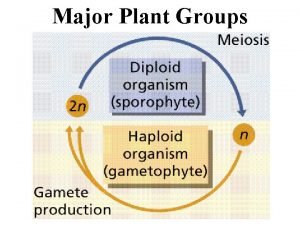Photo recognition Nonvascular Plants Seedless Vascular Plants and

































- Slides: 33

Photo recognition: Non-vascular Plants, Seedless Vascular Plants, and gymnosperms 10 -21 -15 SI Session

The following is a photo of the first plants on land. To which phylum does it belong? A. B. C. D. Bryophyta Hepaticophyta Anthocerophyta Pteridophyta

The following is a photo of the first plants on land. To which phylum does it belong? A. B. C. D. Bryophyta Hepaticophyta (liverworts) Anthocerophyta Pteridophyta

This plant belongs to phylum ______? A. B. C. D. Gymnosperm Lychophyta Hepaticophyta Pteridophyta

This plant belongs to phylum ______? A. B. C. D. Gymnosperm Lychophyta Hepaticophyta Pteridophyta (ferns)

These spots are called ____ and are clusters of ____? A. Sori; sporangia produced by meiosis B. Sori; sporangia produced by mitosis C. Zygotes; gametophytes produced by mitosis D. Zygotes; gametophytes produced by meiosis

These spots are called ____ and are clusters of ____? A. Sori; sporangia produced by meiosis B. Sori; sporangia produced by mitosis C. Zygotes; gametophytes produced by mitosis D. Zygotes; gametophytes produced by meiosis


Which of the following belong to the seedless vascular plants? A. B. C. D. Bryophyta Hepaticophyta Anthocerophyta Equisetophyta

Which of the following belong to the seedless vascular plants? A. B. C. D. Bryophyta Hepaticophyta Anthocerophyta Equisetophyta

Human uses of PHYLUM bryophyta include: A. B. C. D. Increase water retention of soil Fuel to burn Flavor whiskey All of the above

Human uses of PHYLUM bryophyta include: A. B. C. D. Increase water retention of soil Fuel to burn Flavor whiskey All of the above

This plant is (most likely) a member of which phylum? A. B. C. D. Ginkgophyta Cycadophyta Cupressophyta Anthocerophyta

This plant is (most likely) a member of which phylum? A. B. C. D. Ginkgophyta Cycadophyta Cupressophyta (redwood) Anthocerophyta

This plant (based on its leaves and fleshy seed covering) is a member of which phylum? A. B. C. D. Ginkgophyta Cycadophyta Cupressophyta Anthocerophyta

This plant (based on its leaves and fleshy seed covering) is a member of which phylum? A. B. C. D. Ginkgophyta Cycadophyta Cupressophyta Anthocerophyta

This plant is a member of which phylum? A. B. C. D. Ginkgophyta Cycadophyta Cupressophyta Anthocerophyta

This plant is a member of which phylum? A. B. C. D. Ginkgophyta Cycadophyta Cupressophyta Anthocerophyta (hornworts)

This plant is a member of which phylum? A. B. C. D. Ginkgophyta Cycadophyta Cupressophyta Anthocerophyta

This plant is a member of which phylum? A. B. C. D. Ginkgophyta Cycadophyta Cupressophyta Anthocerophyta

Coal is derived from the dead bodies of these plants: A. B. C. D. Seedless vascular Non-vascular Seed plants A&B

Coal is derived from the dead bodies of these plants: A. B. C. D. Seedless vascular Non-vascular Seed plants A&B

The ____ is the dominant stage for seedless vascular plants, & the ____ is the dominant stage for the non-vascular plants. A. B. C. D. Sporophyte; sporophyte Gametophyte; gametophyte Gametophyte; sporophyte Sporophyte; gametophyte

The ____ is the dominant stage for seedless vascular plants, & the ____ is the dominant stage for the non-vascular plants. A. B. C. D. Sporophyte; sporophyte Gametophyte; gametophyte Gametophyte; sporophyte Sporophyte; gametophyte


Plants in phylum ____ produce their spores in ______. A. B. C. D. Gymnosperm; strobuli (cones) Lycophyta; strobuli (cones) Cupressophyta; seeds Pinophyta; seeds

Plants in phylum ____ produce their spores in ______. A. B. C. D. Gymnosperm; strobuli (cones) Lycophyta; strobuli (cones) Cupressophyta; seeds Pinophyta; seeds


Together, these two phyla make up the “conifers”: A. Cycadophyta & Ginkgophyta B. Cupressophyta & Cycadophyta C. Cupressophyta & Pinophyta D. Pinophyta & Cycadophta

Together, these two phyla make up the “conifers”: A. Cycadophyta & Ginkgophyta B. Cupressophyta & Cycadophyta C. Cupressophyta & Pinophyta D. Pinophyta & Cycadophta

My favorite question of all time…. . …

What is the difference between mitosis and meiosis?

Mitosis • Diploid (2 n) OR Haploid (n) • “cloning”: ALWAYS produces two, genetically identical daughter cells Meiosis • Diploid (2 n) haploid (n) • “halving”: ALWAYS produces four, genetically distinct daughter cells
 Nonvascular plants definition
Nonvascular plants definition Nonvascular plants reproduction
Nonvascular plants reproduction Why are nonvascular seedless plants only a few cells thick
Why are nonvascular seedless plants only a few cells thick Multicellular dependent embryos
Multicellular dependent embryos Club mosses, horsetails and ferns are types of _____.
Club mosses, horsetails and ferns are types of _____. Lycopods
Lycopods Seed vs spore
Seed vs spore Heterosporous vs homosporous
Heterosporous vs homosporous Homosporous
Homosporous Image of a cat
Image of a cat Are gymnosperms vascular
Are gymnosperms vascular Strobilus
Strobilus Homosporic
Homosporic Pterophyta dominant generation
Pterophyta dominant generation What seedless plants treat bee stings
What seedless plants treat bee stings Non vascular vs vascular plants
Non vascular vs vascular plants Fern kingdom
Fern kingdom Is algae vascular or nonvascular
Is algae vascular or nonvascular Is a gerber daisy vascular or nonvascular
Is a gerber daisy vascular or nonvascular Coniferophyta vascular or nonvascular
Coniferophyta vascular or nonvascular Dipbot
Dipbot Vascular seed
Vascular seed Xylem and phloem
Xylem and phloem Seedless vascular plant
Seedless vascular plant Vascular and non vascular difference
Vascular and non vascular difference Nonvascular plants phylum name
Nonvascular plants phylum name Common characteristics of plantae
Common characteristics of plantae How seedless plants reproduce
How seedless plants reproduce Why are triploid plants seedless
Why are triploid plants seedless Which seedless plants have been used to treat bee stings
Which seedless plants have been used to treat bee stings Chapter 29 plant diversity
Chapter 29 plant diversity Unit 2 lesson 10 seedless plants
Unit 2 lesson 10 seedless plants Are plants multicellular eukaryotes
Are plants multicellular eukaryotes Resource acquisition and transport in vascular plants
Resource acquisition and transport in vascular plants



